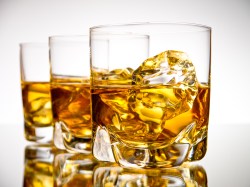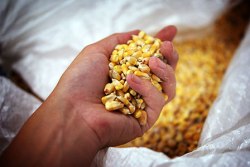
Shutterstock“If I drink all this sustainable booze, I’m kind of a hero.”
Questionable drunk texts aside, many of us believe that our occasional (or frequent, no judgment!) nightcap is basically harmless as long as we’re not doing something stupid or dangerous like operating a motor vehicle. Unfortunately, though, like pretty much everything else we do, what we imbibe has a direct and substantial impact on the environment. According to the June 2012 Research on the Carbon Footprint of Spirits report by the Beverage Industry Environmental Roundtable (BIER), a 750-milliliter bottle of liquor produces, on average, 6.30 pounds of CO2. That’s more than six giant exercise balls full of carbon dioxide for every bottle of whiskey, rum, vodka, gin, or tequila that you consume.
If this depressing news has you once again reaching for the bottle, wait: There’s good news, too. Whether you prefer your drinks sweet like The Vow, spicy like Step Up 2: The Streets, or just plain Magic Mike-naked and unadorned, there are a number of environmentally conscious distilleries to choose from.
Distilling: Waste not, want not?
According to the BIER report (which specifically focused on the life cycle of a North American whiskey but is meant to reflect a typical American spirit), distillation is the No. 1 contributor to a spirit’s carbon footprint, accounting for more than a third of its emissions. That’s largely because in addition to the energy required to power the process, distillation also creates a lot of waste in the form of spent mash, wastewater, and liquor-specific goop like tequila’s acidic pulp and rum’s fibrous leftovers, known as “mostos.” “The actual distillation itself,” says Dänny Ronen of DC Spirits, a food, wine, and spirits organization focused on efficiency and sustainability, “is a very, very wasteful, destructive process.”
But a number of distilleries are finding ways to turn that garbage into gold — or at least into something better than garbage. Like their beer-brewing brethren, distilleries converting spent grain into animal feed is becoming a regular practice, with whiskey giants like Jack Daniels and Maker’s Mark, as well as smaller distilleries like Charleston’s new Striped Pig Distillery and Dad’s Hat Pennsylvania Rye Whiskey, sending their agricultural byproducts off to become livestock feed.
Wastewater can be recycled, too. Mexico’s El Pandillo distillery, responsible for Ocho and G4 tequilas, filters and returns its grey water to the soil that nurtures its prized, individually harvested agaves. And Bacardi Limited, a company whose portfolio includes Bacardi, Dewar’s, Grey Goose, and Bombay Sapphire, has used an anaerobic digester system since 1992 to turn 1.2 million gallons of still bottoms, unfermented molasses, and water into 7 million cubic meters of biogas, which is then used to distill more rum. Even so, Bacardi’s rep isn’t exactly squeaky clean: It ended up on the wrong end of an EPA lawsuit in 2001, when it was accused of violating the Clean Water Act with a 3,000-gallon discharge of industrial waste near the San Juan Bay in Puerto Rico. (It settled in 2008 with a $550,000 fine and a $1 million land preservation donation.)
Ingredients: Some choose local, others go organic, but nobody likes Monsanto.
A fine spirit is more than just the sum of its parts, but those parts account for almost 10 percent of its carbon footprint. As the best distillers already know, the ingredients matter, whether you’re drinking a martini, a Manhattan, or a margarita.
Local sourcing is a common practice for craft distilleries, and vodka is exceptionally well suited for it. Although Lucille Bluth’s favorite breakfast food is typically distilled from grain or potatoes, the spirit can be fermented from a wide range of agricultural products — from sweet potatoes to honey to whey, New York’s widely available yogurt and cheese byproduct. So a distiller has every reason to take advantage of whatever the local bounty offers. Secondly, vodka, by law, generally always tastes the same: It’s defined by the Alcohol and Tobacco Tax and Trade Bureau [PDF] as a “Neutral spirit distilled or treated after distillation … so as to be without distinctive character, aroma, taste or color.” Or as Ronen put it, “Let’s not kid ourselves about how interesting it has to be.” All of this goes for gin, too, as long as there are juniper berries around: The spirit is basically juniper-berry-flavored vodka.
Whiskey producers also find it easy to source their grain locally. Maker’s Mark, for example, sources all of its grains from within a 30-mile radius. (For what it’s worth, considering its sustainability efforts and its willingness to see the error of its ways, I’ve decided to drop my beef against Maker’s for its recent [since quashed] plans to dilute its bourbon. But I won’t tell you to do the same. It’s a decision every whiskey drinker has to make for herself.) For Herman C. Mihalich, founder of Dad’s Hat, using locally grown rye was a “natural fit,” not just because it’s easily available, but also because rye is especially suited to the Pennsylvania environment. “It’s not as demanding as other crops, particularly corn, in terms of energy and pesticides,” he says. “And it’s very useful for soil conservation.” This keeps farmers happy, distillers happy, and — if the Good Food Award Dad’s Hat recently earned tells us anything — it keeps whiskey drinkers happy, too. (The same farmer that delivers rye to Dad’s Hat, by the way, is also the recipient of the distillery’s leftover mash, which he feeds to his “breeding stock,” aka the mothers of the cows that become grass-fed beef.)
Because the uniquely bad practices involved in growing sugarcane often result in soil erosion, water pollution, and heightened carbon monoxide emissions, making sure your rum is responsibly sourced is extra important. Brazil is the world’s No. 1 exporter of sugarcane, a colonial-era cash crop, and most American sugarcane is grown in Florida, Louisiana, Texas, and Hawaii. But craft distilleries outside those states, like Striped Pig Distillery in South Carolina and St. George Spirits in California, still manage to find plenty of locally grown sugarcane and molasses, so you’ve got plenty of “responsible” choices for spiking the fruit punch.
Your tequila, however, is never going to be locally sourced. International law requires that anything calling itself “tequila” be produced in certain areas of Mexico, primarily near a city called — wait for it — Tequila. There are still, though, plenty of well-sourced options for this so-delicious-you’ll-come-back-no-matter-how-bad-your-hangover (or maybe I’m just talking about me) spirit. According to David Driscoll, the Spirits Buyer for K&L and a two-time co-chair of the Good Food Awards Spirits Committee, tequila is one of the two spirits that actually tastes like the fruit it comes from. (Fruit brandy is the other.) “Tequila tastes like agave,” he says. “And if you have really good agave, you have really good tequila.” The best tequila is 100-percent pure blue agave with nothing else added, which makes the quality of the fruit paramount. So who has the best agaves? Driscoll recommends Campeón and ArteNOM, both of which carefully source local agave.
The next question, of course, is what about organic? As I discovered in the world of craft beer, the organic question usually leads to a mixed bag of answers. Besides the aforementioned exceptions, Driscoll says, “there’s not a lot of evidence to show that a flavor of organic or biodynamic grain or fruit really comes through in the final process.” The decision to use organic ingredients is, therefore, “more of a moral quandary right now.”
But not everyone would agree. Melkon Khosrovian, co-founder of Greenbar Distillery, swears by the added flavor of organic fruits, though he describes stumbling upon this fact as an “uncomfortable discovery” when his local farmers started switching to organic agriculture. “It was screwing up all of our ratios for our products,” Khosrovian says. (Personal testing note: I don’t know precisely what it did to the Fruitlab Hibiscus Organic Liqueur’s ratios, but whatever it did, it’s working.) H. Joseph Ehrmann, president of San Francisco Cocktail Week and a brand ambassador for Square One Organic Spirits, also promotes the use of organics — perhaps in part because he shills for an organic company — but also, he says, because “organic” is one of the few government-defined symbols of sustainability out there. Being organic doesn’t just mean using organic ingredients, it also refers to how the stills are cleaned, and in Mexico, it even regulates how the agave can be transported. “[The producers have] to make sure that the trucks that carry the agave once harvested carry nothing but those organic materials,” Ehrmann says. When it comes to making the switch to organic, “a lot of effort goes into it and a lot of expense.”

Striped Pig DistilleryStriped Pig Distillery sources corn, rye and wheat from a single local South Carolina farm.
It’s that added effort and expense that keeps a lot of distillers from jumping on the organic farming wagon. Mihalich, for example, uses some organic ingredients, but for Dad’s Hat’s biggest supplier, “The organic certification is just too much of a hassle for the time being. He’s just not able to do it with the means he has available to him,” he adds. “We’re dealing with small farmers here.” But even if they can’t find certified organic ingredients, most small distillers prefer to steer clear of GMOs. Striped Pig Distillery, for example, doesn’t use organic corn, but its strain, as Johnny Pieper told me, “has been around since the 1800s, so it’s not Monsanto. Those guys are crazy.” (Driscoll says another distillery, bourbon producer Four Roses, also refuses to use GMO or Monsanto corn “just because that’s what they believe in.”)
Nice package, but what a waste.
According to the BIER report, packaging accounts for 20 percent of a distillery’s carbon footprint. Everything from the bottles to the labels to the glue holding the two together and the boxes carrying them to the liquor store has an environmental impact. But craft distillers all over the country are finding ways around it.
Greenbar Distillery, for example, uses glass that’s 25 percent lighter than average, 35 percent post-consumer waste cardboard, 100 percent post-consumer waste recycled paper labels, and even soy-based inks. Those efforts have helped lower the company’s spirits’ footprints to between 1.88 pounds of CO2 per 750-750-milliliter bottle (for its TRU spirits line) to 4.04 pounds (for its imported IXA Tequila), significantly less than the 6.30 pounds the BIER study reported for typical North American liquors.

Striped Pig Distillery’s grain waste gets fed to namesake local residents.
Other distilleries are taking less high-tech, more old-fashioned approaches. Dad’s Hat, for example, partnered up with local glassmaker Anchor Hocking to create its own custom bottle, saving the GHGs many companies are forced to emit when they buy bottles shipped in from overseas. And SF Vodka goes the milkman route, trading empties for discounts on a bar or restaurant’s next round.
Buyer beware: If a company touts how “sustainable” or “green” its liquor is, take a closer look.
For all that’s being done to make your booze better for the planet, if you bring up sustainability with a spirits expert, the first thing you’ll probably hear about is that it’s usually a scam. “I definitely shy away from people who are marketing their products as green,” says Thad Vogler, the owner of San Francisco’s Bar Agricole. “Either it’s a large company trying to fool you or a mediocre company trying to give you another reason to buy their product, other than quality.” Driscoll’s initial response to my inquiry about sustainability in spirits making was similar, warning me to prepare for disappointment. And Ehrmann admitted he’s wary about companies making environmental claims, maybe more so than he should be. “Maybe I get too jaded or bitter from watching this evolve for a while now,” he says. “I’m always skeptical.”
So how can you, the eco-concerned consumer, make sure your next night of YOLO-ing is sponsored by a sustainable spirit? “Do your research,” Ehrmann advises. Not every sustainable distiller will market itself as such, so you might need to do more than just type “sustainable vodka brand” into your search bar. As Driscoll says, “Many of the best products in the world are sustainable, traditional, local — all of these things that we have buzzwords for in the U.S.” But some of the world’s best distillers have been following these traditions since long before they had to market them that way. “They’re just that way because that’s just the way they are.”
If you haven’t done your homework before you get to the store, do it once you’re there. “Most people have a smartphone on them,” Ehrmann astutely observes. “Pick up your phone and Google the company.” But if doing homework at a liquor store sounds like a buzzkill (totally fair), then at least take the time to find a top-notch retailer, even if it means venturing farther than the one on your corner with the bulletproof glass. “The right store has the right people who actually know very, very well all the products they have in front of you,” Ronen says. So pre-party time, let the experts do the work.



